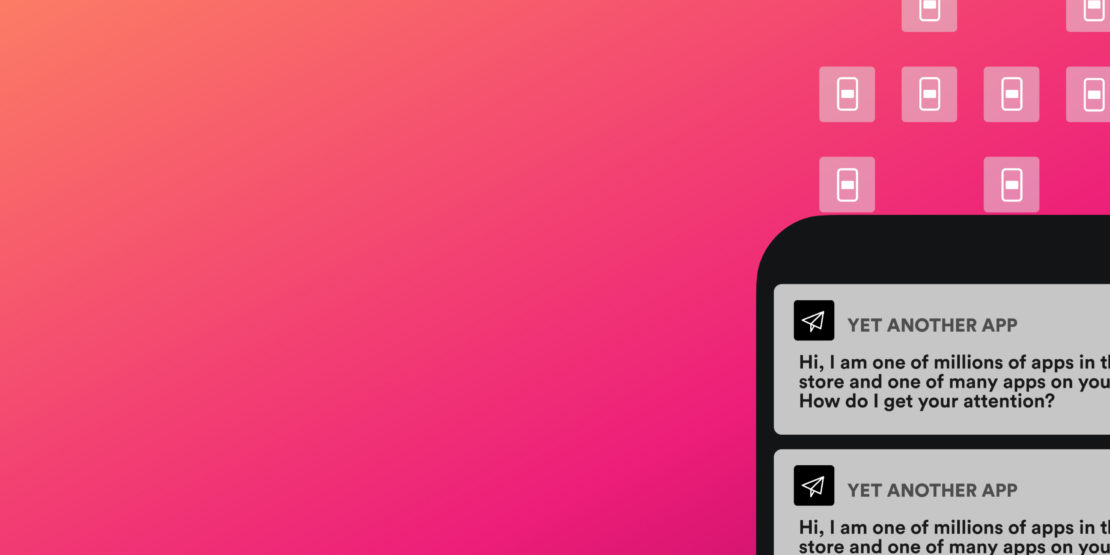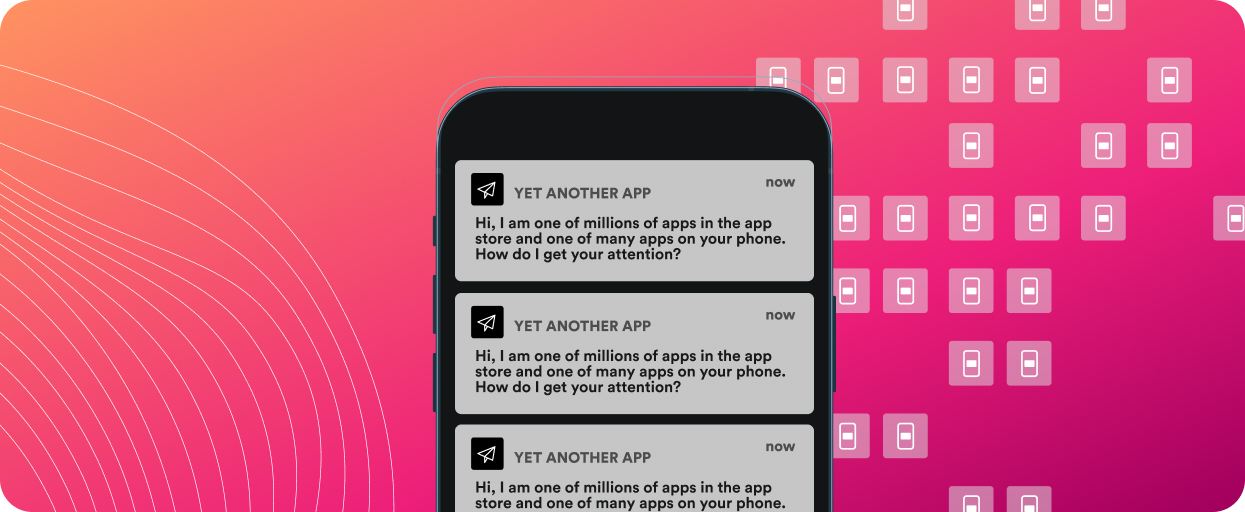A New Mobile App Economy for 2022
Notable 2021 Trends and Impacts
Modern smartphones have evolved at an exponential rate. With faster connection speeds, larger screens, sharper resolutions, and more memory, customers can do so much right from the palm of their hands. That’s why it’s no surprise that consumers are spending more and more time on their mobile devices.
Users spent an average of 4.8 hours a day on their mobile phones in 2021.
More time spent on mobile phones has shifted how businesses interact with consumers. According to data.ai’s (formerly App Annie) The State of Mobile in 2022, users spent an average of 4.8 hours a day on their mobile phones in 2021. This poses a significant opportunity for app businesses.
However, with 2 million apps launched in 2021, and global consumers downloading over 435,000 apps per minute, the amount of competition in this space poses a formidable challenge. How can you increase engagement and promote your app in a crowded market?
Let’s look at some trends based on other findings in this report and what they mean for mobile engagement.
More time is spent on mobile phones than on watching TV
In general, consumers spent more time on their mobile phones, with 3.8 trillion hours spent worldwide — even exceeding the time they spent watching TV. There were 230 billion app downloads with increases in some emerging markets such as India, Pakistan, and Peru at the top. Of the $170 billion in consumer spending on apps and games, 233 apps and games made over $100 million, increasing by 20% from 2020. Demographic trends showed differences by gender and location in preferred app categories.
Consumers spend $16 billion on mobile games
Consumer spending on games totaled $16 billion. Hypercasual games topped the emerging genre category, and 4x march-battle strategy games saw the most monetization. The data.ai report also noted different subgenre preferences by generation (Gen Z, Millennials, and Gen X and Boomers), geography, and gender.
Downloads for meditation apps decreased, dating apps almost doubled since 2018
Subscription apps, like health and fitness and dating, also saw significant increases. Health and fitness saw download numbers higher than before COVID and continue to be high. While the number of downloads decreased for meditation apps, the total time people spent in the app increased. There were also notable generational differences among categories, such as walking, fitness, and meditation apps.
Dating app spending almost doubled in 2018, exceeding $4 billion. Increased spending revolved around four countries (the US, Japan, the UK, and China), and generational differences in-app preferences were prevalent.
Food and drink apps had a nearly 50% increase in sessions
Apps, such as those in food and drink and travel, have seen a rise in usage. Food and drink had a nearly 50% increase in sessions, totaling 62 billion sessions. Consumers were focused on speedy delivery and often searched for apps by brand.
Travel app downloads increased in the last half of 2021. Rideshare apps saw demand normalize, if not increase.
Finance app downloads increased by nearly 30%
Finance app downloads increased by nearly 30% to 5.9 billion. There were distinct trends between generations and locations. For example, Gen Z consumers, appreciating the quick, easy, and flexible use of financial apps, were more likely to use trading apps, neobanks, and money transfer apps. Geographically, neobanks and financial apps were more prevalent in areas with fewer retail banking options.
Mobile retail saw an 18% increase in time spent in apps, totaling more than 100 billion hours globally. Overseas brands also expanded their global reach, and smaller retailers competed with larger shops by running comparable promotions around big events.
Finance and shopping apps are not tapping enough into Gen Z market
Understandably, the insights show marked differences in behaviors and preferences between demographics, such as gender, age, and geography.
For example, different generations show different preferences for specific mobile game types. Gen Z customers are also major social and video content consumers, but there’s also an opportunity for finance and shopping apps to tap into this market.
This reinforces the importance of knowing your audience. And not just that, but the same messaging approach in terms of marketing and content can’t be applied uniformly.
You can use segmentation to target your messaging based on multiple attributes (as many as 2,000) in your user profiles. And advanced capabilities like those in Leanplum allow you to take it a step further by segmenting through real-time user behavior within your app or metrics like recency and frequency for increased personalization to send messages to the right people at the right times.
Mobile ad spend has increased by 23%
Investment in mobile ads increased by 23% in 2021 and is projected to continue at a high rate. With more money going into mobile advertising, you want to ensure you maximize your investment by optimizing your campaigns.
You can use data and analytics to identify which campaigns yielded the highest results and engagement. You can also run A/B tests on different elements to see which ones perform the best.
In turn, you can combine your findings with Leanplum features that allow you to customize your campaigns to quickly switch out copy and content and remote configuration capabilities to determine which elements are displayed. This way, you can ensure you’re showing the most relevant content to your audience segment.
In-app engagement and revenue impact
Data in the health and fitness app category showed that popular meditation apps saw increases of 25% in customer spending and 12-15% for in-app time. Yet, the number of downloads decreased from the previous year.
This highlights the importance of putting efforts beyond customer acquisition and into retention and getting customers back inside your app or continuing to engage with your app.
Cross-channel messaging allows you to send push notifications and emails to re-engage users outside the app. In addition, Leanplum Variables let you create and customize seasonal events or promotions within the app to create new and engaging experiences for your users.
With Leanplum’s remote configuration capabilities, you can also change your app based on real-time user behavior, creating unique experiences based on customers’ preferences and history. This type of personalization can lead to higher engagement rates.
Competing in the modern mobile landscape
Mobile trends, especially within social media, show that consumers are increasingly seeking experiences that offer opportunities to be creative and build relationships.
With the right amount of targeting, optimization, and personalization, you can create messaging and experiences that build those connections and help your app stay relevant to consumers in this ultra-competitive mobile world.
Interested in learning more? Check out some of these additional resources:
- Check out our extensive research and findings on personalization’s impact on Mobile Games and Subscription App engagement.
- Take an inside look to see how you can leverage Leanplum to build engagement through your app messaging and experiences with our interactive Product Tour.
- See Leanplum in action with a complimentary personalized Product Demo.








